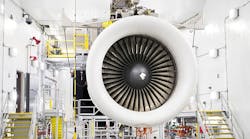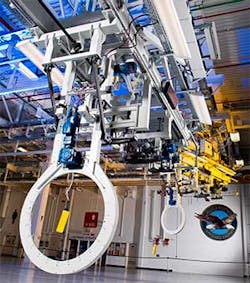While Pratt & Whitney has been located in Middletown, Conn. for 90 years, neither the company nor the state take their relationship for granted.
“Connecticut has let us know that we are a company they value,” explains Joe Sylvestro, vice president of manufacturing operations for Pratt & Whitney.
One clear show of faith was an agreement, endorsed by the Connecticut legislature on April 24, which gave United Technologies Corp. (the parent of Pratt&Whitney) $400 million in tax breaks to upgrade and expand its research, development and manufacturing facilities over the next five years.
United Technologies (UTC), the state’s largest private employer, will invest up to $500 million on a variety of projects. During the same time period, UTC expects to invest up to $4 billion in research and other capital expenditures in the state.
The centerpiece of the investment is a new 425,000-square-foot global headquarters and engineering building for UTC’s Pratt & Whitney division in East Hartford, along with significant capital investments in its factory operations in Middletown and East Hartford.
United Technologies will also:
- Upgrade and expand 100,000 square feet of research and engineering labs at its research facility in East Hartford.
- Build new engineering labs and a 12,000-square-foot global customer training center at its Aerospace Systems business in Windsor Locks.
- Make significant capital investments at its Sikorsky facility in Stratford, including improvements to engineering and design labs and upgrading its manufacturing capabilities.
In the middle of all of this expansion two months ago the Middletown production facility unveiled an innovative jet assembly engine line; a horizontal assembly line. It will support production of the PurePower PW1100G-JM engine for the Airbus A32Oneo and the F135 Lightning II Joint Strike Fighter.
With a large demand for the engine, the plant had to ensure that it was ready to “more than double engine production to keep up with customer demand,” explained Sylvestro. “The horizontal assembly line is a lean and more efficient way to build engines.”
The horizontal assembly line provides ergonomic benefits for the assembly teams as the mechanic can adjust the engine up and down to their ideal work height, and can rotate the engine to help with difficult to reach areas. The new line is also safer because ladders and platforms have been fully eliminated, and there is no perching under the engines, bending, stooping and climbing. “The new line is receiving approval of many employees and we are even getting requests from our long-time employees who want to work on this new line,” Sylvestro said. ( For more on this new line see Pratt & Whitney Builds for the Future.)
Keeping workers happy is something the company has achieved, however it is mindful of the need to have a talent pipeline. The company has a variety of strategies which includes hiring from the U.S. military. “This population is a good fit as they are trained, disciplined and have a high maturity level,” says Sylvestro.
The company also works closely with area educational institutions and provides equipment when necessary. Connecticut has over 42 colleges and universities.
The education institutions are collaborating with both companies such as Pratt& Whitney and the state government to ensure the workforce will gain the skills needed for future production.
Strengthening the Areospace Supply Chain
“As the production schedules of companies like Boeing, Airbus, and UTC become increasingly aggressive, the state’s aerospace supply chain must be prepared to nearly double their capacity to meet this demand and the advanced nature of their work,” said Governor Dannel P. Malloy. “Although Connecticut’s manufacturers are among the best at what they do, a major ramp-up in production activity could pose a challenge for our smaller producers,” the Governor said last January when he introduced a new Advanced Manufacturing Fund.
The Advanced Manufacturing Fund, which began with an initial investment of $25 million, helps companies modernize and grow, purchase equipment and develop new technologies, and provide access to training and specialized education for workers.
“Three things are needed for Connecticut’s manufacturing sector to strengthen and grow: new technologies and products, the talent to create and develop them, and the capital to fund capital to fund those entrepreneurs and ideas,” said Department of Economic and Community Development Commissioner Catherine Smith. “Now is the right time for the state to attract and retain those people and ideas – building on Connecticut’s already strong, yet vulnerable position as a global source of manufacturing expertise and innovation – by ensuring that our companies have access to what they need to increase skilled manufacturing job growth. This new fund is dedicated to doing just that.”
One especially important component of future growth is 3-D manufacturing. The aerospace industry is already exploring its application. In fact one Connecticut manufacturer, Oxford Performance Materials (OPM) opened up a new facility in South Windsor in 2013 to support 3-D printing of aerospace components.
The new OPM facility was created to house a number of printers (EOSINT P 800) which are capable of printing high performance thermoplastics such as the firm’s OXPEKK formulation.
The company's first application of its material was in the biomedical sector. In 2013 the company became the only company to receive FDA clearance to manufacture 3-D printed patient‐specific polymeric implants for its cranial prostheses line and it received approval for patient-specific facial implants in July 2014.
However the new facility will be used for the production of additively manufactured industrial and aerospace parts. "It has always been our intention to pivot from biomedical 3-D printing to Mission Critical aerospace and industrial structures," said Scott DeFelice, CEO of OPM.
Applications within aerospace components include: complex assemblies, low series labor and capital intensive production parts, high series labor-intensive-production parts, parts required to meet interior aircraft smoke and toxicity (UL VO, OHS), weight and part-count reduction objectives and replacing intricately-machined aluminum or composites.
The company has a very clear sense of its place in the world. “We are here to solve big problems with our technology, “ says DeFelice. In fact the company’s mission states that advances in materials sciences "deeply affect the course of human evolution. No part of our modern existence remains untouched by the complex materials we come into contact with every day."
This socially-based mission is also a perfect fit for the company’s desired workforce. “We feel this mission will attract the best and the brightest, “ DeFelice says. “We can continue to grow a business that both rewards our shareholders and solve these important issues.”
Part of the company’s method to attract talent is to work with University of Connecticut. “This university has established a significant leadership position within additive manufacturing,” says Paul Martin, the company’s aerospace president. “Given the contribution these new materials will have to the aerospace industry, young engineering students need to learn about these new tools and methods.”
The state is very active in providing the education for the future, says DeFelice. “The state has invested in a big way on STEM education and has invested in providing professors who are dedicated to additive manufacturing. That shows a lot of commitment.”
The state’s $1.8 billion Next Generation Connecticut initiative, which became effective in 2013, calls for investing in building new facilities and renovating old facilities to accommodate an additional 6,580 new students and 259 new faculty at the UConn Storrs and Stamford campuses.
Not only are these state investments a show of collaboration between current and future industry, but are a necessity says Sylvestro. “We are competing globally, and it’s important for local regions to always keep that front and center.”
Sylvestro invests his time as an appointed member to the manufacturing council of the U.S. Department of Commerce, making sure that message gets out. “The council is working with private industry on ways to make the U.S. more competitive. State and local communities must be working toward that same goal as well.”





